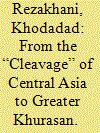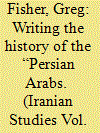| Srl | Item |
| 1 |
ID:
144713


|
|
|
|
|
| Summary/Abstract |
The history of Central Asia is normally considered peripheral to those of the civilizations that surrounded it—Marshal Hodgson termed it a civilizational “cleavage.” However, in the early Islamic period this region, particularly its southern and western parts, emerges as the dominant entity of Greater Khurasan to play a central role in the affairs of the Islamic Caliphate. This paper considers the history of the region, dubbed East Iran, before this rise to importance and proposes a different historiographical approach focusing on the developments in East Iran during the period of late antiquity and in interaction with the Sasanian Empire. It is proposed that the Greater Khurasan emerged as the result of the merging of the socio-cultural worlds of East Iran and that of the Sasanian Empire.
|
|
|
|
|
|
|
|
|
|
|
|
|
|
|
|
| 2 |
ID:
160284


|
|
|
|
|
| Summary/Abstract |
Qianling Mausoleum (乾陵) which is located in the northwest of Xi'an, is the tomb of Emperor Gaozong of the Tang Dynasty (唐高宗, r. 649–83 AD) and his Empress Wu Zetian (武則天, r. 690–705 AD). In this mausoleum, there are two statues of Pērōz, son of Yazdegird III (632–51 AD), and another Persian nobleman who have been recognized by western scholars. However, scholars’ attention has been limited to a general and mistaken description of the statues. This paper reassesses both statues in order to give some new insight into the head of one of the statues found at the Qianling Mausoleum.
|
|
|
|
|
|
|
|
|
|
|
|
|
|
|
|
| 3 |
ID:
144716


|
|
|
|
|
| Summary/Abstract |
Modern scholarship on Arabs in the pre-Islamic period has focused on Rome's Arab allies—the so-called “Jafnids” or “Ghassānids,” with much less attention paid to Persia's Arab allies, the so-called “Naṣrid” or “Lakhmid” dynasty of Arab leaders at al-Ḥīrah in Iraq. This article examines select pre-Islamic sources for the Persian Arabs, showing that even with the meager evidence available to us, and the lack of archaeological material, it is possible to draw a relatively complex portrait of the Persian Arabs. This article situates the Persian Arabs as important figures in some key themes and phenomena of late antiquity, such as the growth of Christian communities, the conflict between Rome and Persia, and the struggle for influence in the Arabian peninsula.
|
|
|
|
|
|
|
|
|
|
|
|
|
|
|
|